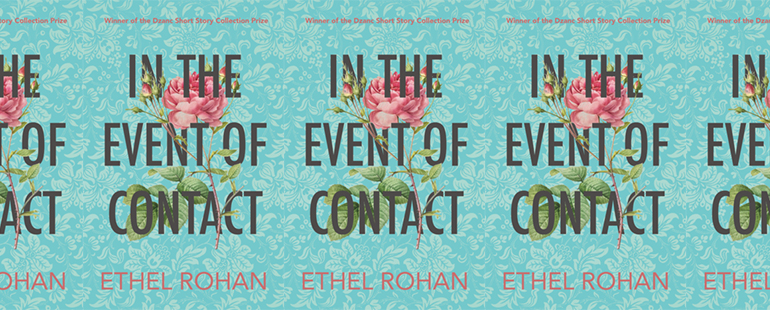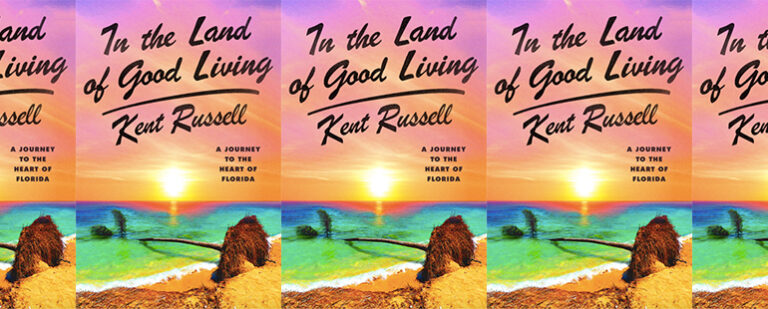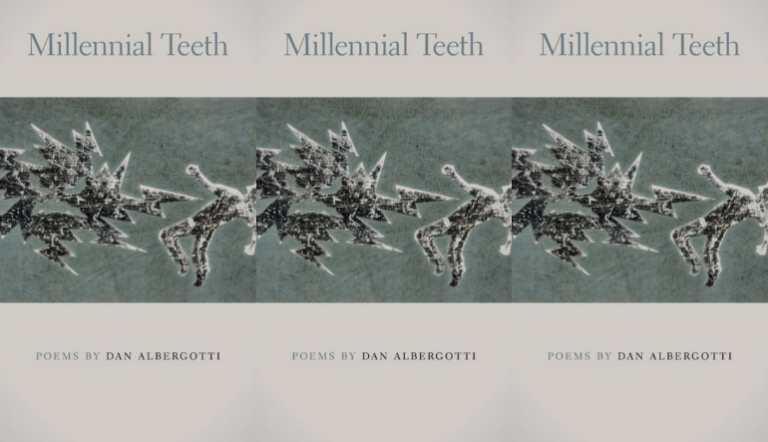“I’m not sure we ever arrive at wholeness”: An Interview with Ethel Rohan

Ethel Rohan’s stories are expertly laced with opposition and convergence, a curled fist and an open palm. In the Event of Contact, her most recent collection—out this week—features relationships rife with both dissonance and confluence, characters in pairs and triads stretching away and snapping back together. Mixing distance and waning passion with longing for repair and resolve, its stories bloom in equal parts hurt and reconciliation. Cultures merge, too, in the collection, Rohan’s meticulously crafted stories reflecting emigration and identity struggles on top of clashing relationships. And while there is a profound focus on suffering and trauma throughout, there is also a flush of characters seeking wholeness, striving for self-acceptance as a means to heal, as a means to grow, as a means of survival.
“Blue Hot” is a prime example of the trauma and frightening abuses Rohan places sharply before the reader. In haunting and vibrant prose, we’re put on alert when the story opens with violence: “He spilled blood on our first date.” Though this blood is someone else’s, resulting from a fight that ensues after a movie, the narrator’s relationship with “him” moves swiftly into jealousies, insinuating words, and her inability to shake off the notion that his violence is coming for her, too. In the final stretches of the story, Rohan finally unleashes the full magnitude of what we’ve suspected: “There in the dark garden, he bunched my hair in his fist, threatening to smash my head against the concrete wall. ‘Do it,’ I said through gritted teeth.”
“Into the West” takes up a less violent but not less significant instance of crisis, another character on the brink of disintegration. Fintin’s mother is visiting from Ireland, and with her she brings a cultural heritage that clashes with his newly formed emigrant life in San Francisco. “Everything’s bigger in America. It’s pitiful,” she says, touring through his beautiful and lavish home. Compounding the stress of the visit is Fintin’s affair, which could be unearthed at any moment by the injection of his mother into his otherwise faux-idyllic scene: “‘You’re a terrible liar,’ she said. He couldn’t hold her gaze. The Wife is going to find out sooner or later. They always do.” He is caught in a two-fold clash, his own decomposing identity and his familial and cultural heritage infiltrating a newly formed existence in another country. The story is a dissolution, a slow severing, complicated by opposing forces and a fractured identity.
And yet, even with all the trauma present in In the Event of Contact, many stories are ultimately seated in a conclusive note of survival, of healing. “Everywhere She Went” features an unnamed woman protagonist fighting to overcome the grief of a lost friend. Her best friend, Hazel, went missing from a dark road long ago, and the protagonist is struggling to stop seeing her in everything. Meanwhile, she is grappling with a relationship on the eve of collapse: “That groove appears between his eyebrows, like a coin slot in a vending machine. I realize there isn’t anything I want to select from inside him.” When her boyfriend starts complaining about someone at work named Hazel, then, her trauma is doubled, building to a climax in which she is finally able to excise the waning relationship and begin focusing on her own healing. In the end, she is a survivor, standing in front of a dry moat surrounding the Tower of London: “My hand finds the cool coins inside my jacket pocket. I bunch the money in my fist and fire. The rounds of silver and copper fly through the air, not as barter for a wish to be granted, I decide, but in final repayment for any debts owed.”
Opposition and confluence, emigration and identity, trauma and healing equally resound in In the Event of Contact, though the singular thematic thread of survival ties these subjects together in the end. Rohan dedicates the collection “to Survivors,” to those who have suffered and lost, those who have limped through and out of relationships in order to forge new identities, to better love themselves, to find beauty after trauma. Rohan includes her identity in this, too, giving the last thanks in the acknowledgments to her past self: “Finally, thank you to the girl and teen I was—crushed but still standing.” In the Event of Contact reverberates with this ultra-personal stake, made palpable in the cultures, characters, and relationships woven into its earnest, artful, and heartfelt stories.
J. A. Tyler: The titular story involves triplets, and several other pieces are configured with triads or character triangulations, typically foisting one person to the side. Can you talk a little about this type of story setup or theme in the collection?
Ethel Rohan: In storytelling, I’m most invested in characters and their relationships. People fascinate, inspire, disappoint, and sometimes horrify me. I’m obsessed with why we are the way we are. Those answers are unique to each of us and make for rich material in storytelling. Triads are a particularly ripe setup for characterization and tension. We’re programmed to pair and in threesomes the power dynamics tend to shift, exerting pressure on the alliance and typically alienating one of the three.
I didn’t consciously enter any of these stories with the intention of creating character triangulations, and yet there they are, a repeating motif throughout the collection. Every story is a series of choices and opportunities, and it’s clear I repeatedly choose to crack open the layers, and fallout, of three.
JAT: You’ve written a novel—The Weight of Him (2017)—and three other story collections. How do you know when a piece is a story as opposed to the start of a novel? Do stories ever vie for your elongated attention, pressing to become a book instead of a short story?
ER: With the notable exception of The Weight of Him, I’ve never confused whether or not I’m writing a short story or a novel. Frankly, it’s a mystery to me how I know. I just do. That’s especially peculiar given that when I enter a story and its world I never know what’s before me. I don’t outline. I don’t plan. I start with a spark—that moment, phrase, place, or character—that triggers each new beginning and I go scene by scene from there. The work itself has its own intelligence, and we alternatively trust and surrender to each other.
I would have happily remained inside most of the short stories in this collection over the course of a novel—in particular, “Rare, But Not Impossible,” “At the Side of the Road,” and “Any Wonder Left”—but nothing about stories can be forced and the collection gave up all of itself as is. Fear clouded my instincts and judgment when I began writing my novel The Weight of Him. I entered the work as a short story and stayed stuck there for years. Much of the material frightened me, and required me to face my own demons around food disorder, body dissociation, and suicidal ideation. I resisted staying in its world over the course of a novel until the story, and its characters, wouldn’t allow me to keep avoiding and demanded I go all in.
JAT: In terms of craft, how do you know when a piece is finished? How do you decide when to leave it alone?
ER: When is a piece finished? That is the million-dollar question. I can only offer the same maddening answer I gave earlier: you just know. The knowingness comes with practice and doing the work. Early drafts are telling myself the story—who and where it’s about, and Why now? Later drafts are more concerned with what’s at stake and what’s the center—the urgent, beating heart—of the story. Final drafts are fixated on every word being in service of that beating heart and ensuring its existence matters in ways moving, meaningful, and crackling.
It’s also less a case of deeming the work finished and more my reaching the point where I can let the work go. I let go when I believe I’ve done everything possible to tell the best story I can. One gauge I use is to read final drafts aloud and when the words as a whole reach a certain rhythm, crescendo, and fade out—when the work sings for me—I experience a satisfying sense of rightness and completeness.
No story is ever going to be as great as I want it to be—storytelling is an unconquerable beast and I’m forever its student—but when I let the writing go it’s with the belief that it’s worthy of being read. And I can never leave the work alone. I’m always tinkering and polishing, even after publishing. In that sense, a piece is never finished. Similarly, published work is never finished as long as readers are engaging with it. Readers’ experiences with the story cause it to shapeshift and never become static.
JAT: Does this mean that you edit and revise some pieces even after publication? What does that look like?
ER: Guilty as charged! It’s typically a situation where I’m reading my published work aloud, preparing for an event, and I find myself tinkering with an imprecise word or phrase, or a sentence(s) that needs further tightening. In a flurry, I pen edits on the published page. Small stuff, generally. With In the Event of Contact, six of the fourteen stories were previously published. Yet I revised each of those six quite a bit for the collection. My best is always a moving target.
In particular, “Before Storms Had Names” is a shorter, sharper, and more honest story than when it was previously published years ago by BULL Magazine. I reworked it with a fuller understanding of the characters, and in particular the protagonist, Rory. Because of that, the ending is markedly different. In the originally published version, the story ends with Rory committing rape. In the “final” version contained in the collection, he does not. I came to this different ending because Rory, although deeply flawed, showed himself to be ultimately incapable of the crime. While I don’t feel I unduly manipulated the story to get to that ending—rather I finally got to its heart and truth—I did rejoice in at least one less rape in the fictional world.
JAT: You were born in Ireland and live now in San Francisco, two locales featured in the collection. Do you find both places equally inspiring in your work? And how does the notion of emigration influence your writing?
ER: My story impulses most often return to Ireland and my beginnings. My childhood was filled with a trove of strangeness that energizes my creativity and fuels my imagination. Much of the most startling moments in the collection draw on events that I experienced in Ireland both while living there and on my annual return visits. My life in San Francisco is much tamer and happier in comparison, for which I’m deeply grateful. Even as I’m perhaps less inspired by the everydayness of my adopted, (largely) beautiful city and its environs.
Emigration, and its inherent fracture, is an enormous influence on my writing.
Although even before emigrating from Ireland to San Francisco as a young adult, I suffered a sense of splitness. There’s the larger cultural context of the island of Ireland’s division—the twenty-six counties of the Republic and the six counties of the United Kingdom. There’s also the personal splitness I suffered as a child and teen, the before and after of sexual, physical, and emotional abuse. Then there followed my fixation with an alternate self, the me I would have been if I were never abused. To my detriment, I idealized that other self and became the shadow self. A large and necessary part of my recovery was integrating the real and imagined versions of myself, including my inner child, and practicing self-acceptance and self-love. I’m not sure we ever arrive at wholeness, though, and my stories reflect that.
JAT: Which is your favorite story in the collection, and which is the one you have the most difficult relationship with, either in the writing of it or in letting it go as a published piece?
ER: Despite its central theme of genetic mental disorder, “Wilde” was largely a trip to write. The story flowed in early drafts at an exhilarating pace and repeatedly surprised me with its plot and character turns. I could just about keep up with its momentum when first getting the story down.
“Rare, But Not Impossible,” and “Any Wonder Left,” are probably my two favorites, though. And “F Is for Something.” See what you started? I can’t decide. The stories are fourteen different-colored ribbons pulled from my chest.
The most difficult story to write and publish was “Blue Hot.” That story of maternal and partner abuse came from a deep place of sorrow, and defiance. I want my work to center strong women characters, but they often arrive to me broken and hurting. I then walk the tightrope of rendering their wounds, pain, dignity, resilience, and survivorhood over the course of the story.
At the last moment in the editing process, I pulled a final paragraph from “Blue Hot.” One that offered the reader more of a resolution and an empowered character, but it was most honest to end the story where I did, in the shattering moment. My touch as a creator is light, there’s enough trauma in the world. I’m here for making beauty from the broken. Just not for faking it. I wanted the closing disturbance to hang in the air. To invite readers to maybe think how every day, every single day the world over, girls and women suffer myriad forms of abuse and assault, go missing, and are murdered. We’ve allowed that horror to become ordinary and not even noteworthy. Like it’s nothing.


